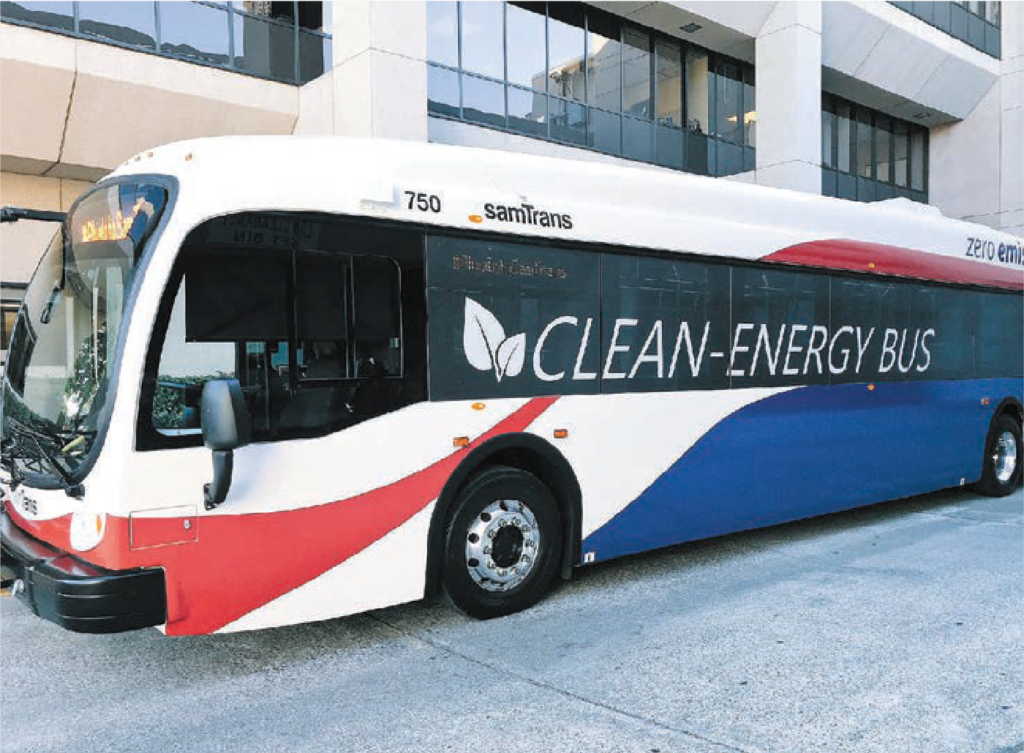Community Impact Report 2020
ELECTRIFYING THE FUTURE
SamTrans bus system is on track to be all-electric and emission-free
| BY ALLEN PIERLEONI |
The San Mateo County Transit District (SMCTD) is looking into the future, and what it sees is electric-powered buses and trains that will move public transportation into a new era of emission-free sustainability and clean energy.
Its SamTrans bus system is “on track to convert our fleet to 100%
zero emissions by 2040,” says Amelia Timbers, SMCTD’s principal planner for sustainability.
“We’ve just begun this transition,” she says. “We have two battery-electric buses now, with eight more coming in the near future.”
SamTrans sources 100% renewable energy from Peninsula Clean Energy’s ECO100 product. The bus fleet services San Mateo County and parts of San Francisco and Palo Alto.
“The community response to electric buses has been really positive,” Timbers says. “Our riders are excited about the growth of the fleet. We’ve displayed the buses at festivals, where they’ve been very popular.”
In addition to the bus fleet is SMCTD’s Caltrain, with a fleet of 134 passenger cars, each seating between 78 and 149 travelers. But that will change when the Caltrain Peninsula Corridor Electrification Project is in place, eventually eliminating the need for diesel-driven locomotives.
“We’re very much in the planning stage, but we have already purchased 133 electric-fueled self-propelled mobile units for 19 seven-car trainsets (each car holding 600 to 700 passengers),” Timbers says. “We plan to start electric service for most of the Caltrain Corridor by 2022.”
Caltrain serves from Oracle Park in San Francisco, south through San Mateo County to Gilroy.
“It’s not just a matter of getting electric trains, but also a matter of getting the electric infrastructure along the corridor,” points out Dan Lieberman, SMCTA public affairs specialist. “We’re now erecting poles to support the catenary system
(overhead wires) that will provide electric power to the trains.”
Current yearly passenger numbers are startling – 11 million riders for SamTrans and 18 million for Caltrain. Compared to 2019, projections show a potential 300% increase in demand for the Caltrain system by 2040.
“The community response to electric buses has been really positive.”
Amelia Timbers
SMCTD’s principal planner for sustainability
“We don’t expect electrifying SamTrans to have as immediate an effect on bus ridership, but it will certainly help to shrink our carbon footprint and reduce the amount of particulate matter in the air,” Lieberman says.
“Electrifying a railroad does have huge environmental benefits, but it will also allow us to increase the frequency of our service and move more people faster,” he says.
“Electrifying (SamTrans and Caltrain) will help us operate a cleaner fleet overall,” Timbers says. “We consider ourselves a mobility leader, and a big part of that is ensuring we’re contributing to a sustainable future that meets our diverse community and ridership needs.”


Lyngso Garden Materials, a renewable connection
“Anything that helps grow plants or is related to landscaping, we have here,” says Kan Parthiban, sustainability coordinator of green-devoted Lyngso Garden Materials in San Carlos. That includes organic composts, soils and fertilizers, of course, but the family-run employee-owned business is also the source
of larger landscaping items, such as boulders, flagstones and rocks, water features and pottery.
“What ties everything together is our community involvement, sustainability
of raw materials
and environmental conscientiousness,” she says. As part of that, Lyngso upgraded to Peninsula Clean Energy’s ECO100 product, which provides energy from 100% renewable sources.
Lyngso has held free Saturday learning sessions for more than a decade. “We host DIY classes and educational classes with the UC Master Gardeners,” Parthiban says.
“We have been a community resource and a people-based business since the early 1950s.”
Another key is the emphasis on organics. “We don’t have any synthetics or chemical products on site,” she says.
“Our customers care about the environment, so all of our soils and amendments are natural and eco-friendly.”